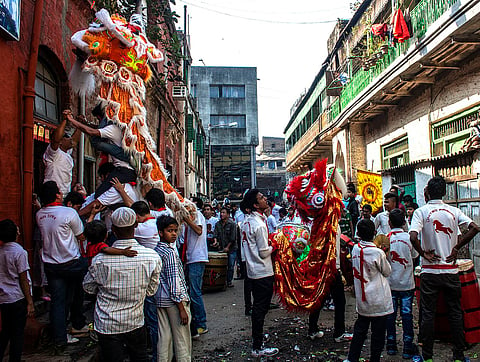From Achipur to Tangra
The traditional Chinese dragon dance breathes an indescribable liveliness into the Chinese New Year celebrations each year. The beating of drums echoes through the air, as the dancers sway ferociously to keep step with every beat. The small crowd applauds enthusiastically, mesmerised by the effortless twisting and undulating of the giant dragon. There is a frenetic energy here, and one cannot help but move along with the music. Such celebrations take place across the vast Chinese landscape, of course; this one, however, is taking place far removed, on the sidewalk of a busy street in Calcutta. Then again, the scene is hardly alien, for the Indian Chinese have been an integral part of the city's make-up for more than a century. The demographics have been changing, however, as many Indian Chinese leave for shores beyond the Hooghly. Chinatown, meanwhile, has been slowly crumbling from neglect and indifference.
The Buddhist monk Fa-Hien's journey to the Subcontinent – in present-day Nepal, India and Sri Lanka – during the fifth century AD is well known to many, due to the meticulous records that he kept during the experience. What is largely unrecorded is that Chinese traders, scholars and monks wandered the area for centuries thereafter. Their presence may not be etched in history, but their influence on the region certainly is. For instance, the Bengali word chinamati, literally translated as 'mud from China', is to this day used to describe porcelain. Centuries later, in 1778, Yong Atchew landed on the banks of Hooghly, to become the first Chinese settler in India. Atchew's initial experiences in Calcutta are clearly laid out in the records of the East India Company. That year, according to the papers, a trader named 'Achi' petitioned Warren Hastings, then governor-general of Bengal, for land on which to establish a commercial enterprise. The request was granted, and he acquired a large plot some 33 km away from Calcutta, just south of the town of Budge Budge. There, Atchew set up a sugar mill, for which he brought in migrant workers from China. Many of these would eventually make Calcutta their home. The raw material for the mill was provided by a nearby sugarcane plantation that Atchew also owned. The mill became a focal point around which a quiet Chinese settlement would flourish, and the village was named Achipur, after Yong Atchew. The Chinese have long left Achipur, but their presence continues to echo through the beautiful ancient Chinese temple there, where the deities Khuda and Khudi are propitiated. The colours of the walls have faded with the passage of time, but the intricate wood carvings and Chinese inscriptions remain intact. A little distance away is a simple horseshoe-shaped grave, the resting place of Yong Atchew. Today, the village is a quiet one; but it comes to life every year during the Chinese New Year, as the Chinese community returns to Achipur to celebrate its founder's life and legacy.

